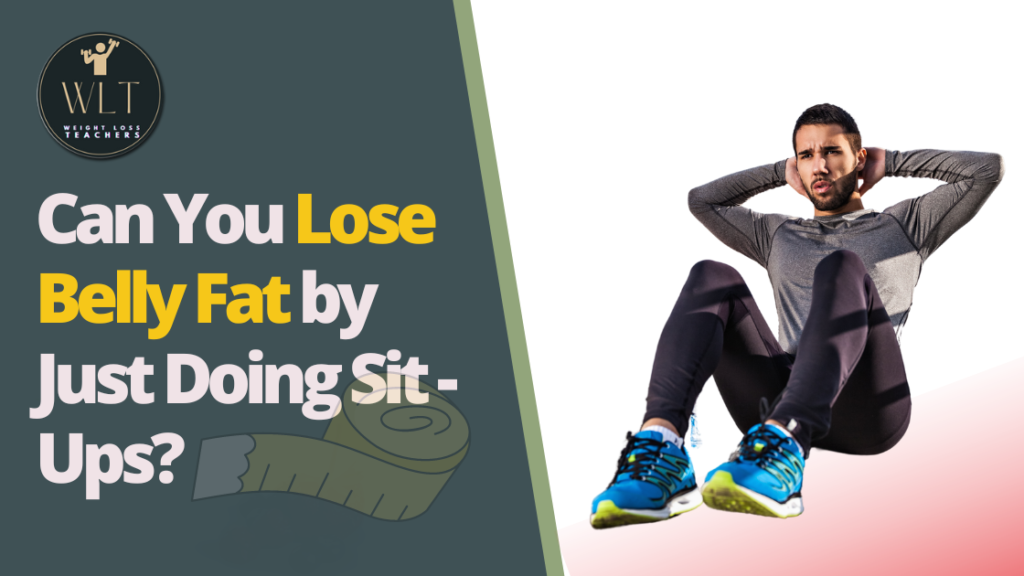
Can You Lose Belly Fat by Just Doing Sit-Ups?

Losing belly fat is a common fitness goal for many individuals. While spot reduction, the idea of targeting specific areas for fat loss, has been widely debated, sit-ups are often considered an effective exercise for toning the abdominal muscles. However, the question remains: Can you lose belly fat by just doing sit-ups?
Table of Contents
Can You Lose Belly Fat by Just Doing Sit-Ups?
In this comprehensive article, we will delve into the science behind fat loss, the role of sit-ups in abdominal muscle development, and explore a holistic approach to achieving a flat stomach. We will examine the importance of nutrition, overall exercise routine, and dispel common misconceptions related to spot reduction.
Section 1: Understanding Belly Fat and Fat Loss

- What is belly fat?
Belly fat, also known as visceral fat, is a fat that accumulates around the abdominal organs. It is different from subcutaneous fat, which is the fat found just beneath the skin. Belly fat is considered more metabolically active and poses greater health risks compared to subcutaneous fat.
- Different types of body fat
Our bodies store fat in various areas, including the abdomen, thighs, hips, and arms. The distribution of fat is influenced by factors such as genetics, hormones, and lifestyle. However, belly fat, particularly the fat around the organs, has been linked to an increased risk of heart disease, diabetes, and other metabolic disorders.
- The health risks associated with belly fat
Excess belly fat is associated with a higher risk of developing chronic diseases. Studies have shown that individuals with excessive belly fat are more prone to insulin resistance, high blood pressure, high cholesterol levels, and inflammation, which can contribute to cardiovascular diseases and type 2 diabetes.
- The science behind fat loss
Fat loss occurs when the body is in a state of negative energy balance, meaning you consume fewer calories than you expend. This creates a caloric deficit, forcing the body to tap into its stored fat reserves for energy. As a result, fat cells shrink, leading to overall body fat reduction.
- The role of genetics in fat distribution
Genetics plays a role in determining where your body stores fat. Some individuals may be genetically predisposed to accumulate more fat in the abdominal region, while others may store fat in different areas. However, it is important to note that genetic factors do not prevent fat loss but may influence the rate and distribution of fat loss.
- Caloric deficit and its impact on fat loss
To lose belly fat or any body fat, it is essential to create a caloric deficit. This can be achieved by consuming fewer calories through a balanced diet and increasing energy expenditure through physical activity. The body will then utilize stored fat as an energy source, resulting in overall fat loss, including in the abdominal region.
Section 2: Role of Sit-ups in Abdominal Muscle Development

- What are sit-ups?
Sit-ups are a common abdominal exercise that involves lying on your back, bending your knees, and lifting your torso towards your thighs. This movement primarily engages the rectus abdominis, commonly known as the “six-pack” muscles, along with other muscles such as the obliques and hip flexors.
- Targeting the abdominal muscles
Sit-ups are effective for targeting and strengthening the abdominal muscles. When performed correctly and consistently, they can help develop core stability and improve muscle tone. However, it is important to note that sit-ups alone cannot selectively burn belly fat.
- Benefits of sit-ups
Sit-ups offer several benefits beyond muscle development. They help improve posture, enhance spinal flexibility, and increase overall core strength. Additionally, a strong core can improve athletic performance, balance, and reduce the risk of back injuries.
- Limitations of sit-ups for belly fat loss
Contrary to popular belief, sit-ups do not directly burn belly fat. While they strengthen the abdominal muscles, they do not cause significant calorie expenditure or create a large enough metabolic demand to result in substantial fat loss. Fat loss is a systemic process that occurs throughout the body and cannot be targeted to specific areas.
- Strengthening and toning the abdominal muscles
Although sit-ups may not directly lead to belly fat loss, they can play a role in sculpting and toning the abdominal muscles. When combined with an overall exercise routine and a healthy diet, sit-ups can contribute to achieving a more defined and toned abdominal area. By strengthening the muscles, sit-ups can improve the appearance of the midsection and create a more sculpted look.
Section 3: Holistic Approach to Belly Fat Loss

- Importance of nutrition in fat loss
While exercise plays a vital role in overall health and fitness, nutrition is equally important, if not more, when it comes to losing belly fat. Consuming a balanced diet that includes whole foods, lean proteins, fruits, vegetables, and healthy fats is crucial for creating a caloric deficit and providing the body with essential nutrients.
- Creating a calorie deficit through diet
To lose belly fat, it is necessary to consume fewer calories than your body needs. This can be achieved by tracking your daily calorie intake and ensuring it is lower than your total daily energy expenditure (TDEE). Incorporating portion control, reducing processed foods, and focusing on nutrient-dense, low-calorie foods can help create a sustainable calorie deficit.
- The role of cardio exercises in overall fat burning
Cardiovascular exercises, such as running, cycling, swimming, or high-intensity interval training (HIIT), are effective for burning calories and increasing overall fat loss. Engaging in regular cardio workouts can help create a greater calorie deficit, contributing to the reduction of belly fat and overall body fat percentage.
- Incorporating resistance training for body composition changes
Resistance training, including exercises such as weightlifting, can help build lean muscle mass. As muscle is metabolically active, it increases the body’s basal metabolic rate (BMR), resulting in more calories burned at rest. By incorporating resistance training into your fitness routine, you can improve body composition and support long-term fat loss goals.
- High-intensity interval training (HIIT) for boosting metabolism
HIIT workouts involve short bursts of intense exercise followed by periods of active recovery. These workouts are known to boost metabolism and increase the body’s calorie-burning potential even after the workout is completed. Including HIIT sessions in your exercise routine can enhance overall fat loss, including in the belly area.
- Core-strengthening exercises for overall abdominal development
In addition to sit-ups, there are various core-strengthening exercises that target the abdominal muscles and contribute to overall development. Planks, Russian twists, bicycle crunches, and mountain climbers are examples of exercises that engage the core muscles and can be incorporated into a comprehensive workout routine.
- Stress management and its impact on belly fat
Chronic stress can contribute to weight gain and the accumulation of belly fat. Elevated levels of the stress hormone cortisol can increase appetite and lead to the storage of excess fat around the abdomen. Practicing stress management techniques such as meditation, yoga, or engaging in hobbies can help reduce stress levels and support belly fat loss.
Section 4: Debunking Common Misconceptions

- Spot reduction and its limitations
Spot reduction, the idea that you can selectively burn fat from specific areas of the body, is a common misconception. The body loses fat in a systemic manner, based on genetic factors and overall energy balance. While exercises like sit-ups strengthen the abdominal muscles, they do not directly target belly fat.
- Waist trainers and other gimmicks
The market is flooded with products like waist trainers that claim to aid in belly fat loss. However, there is no scientific evidence to support the effectiveness of these products. Waist trainers may temporarily compress the midsection, giving the appearance of a slimmer waist, but they do not contribute to long-term fat loss.
- The role of genetics in fat loss
Genetics can influence how and where your body stores fat, but they do not determine your ability to lose belly fat. While some individuals may have a genetic predisposition to store more fat in the abdominal area, it is important to note that everyone has the potential to lose belly fat through a combination of proper nutrition, exercise, and lifestyle choices. Genetics may influence the rate and distribution of fat loss, but they do not make it impossible to achieve a flat stomach.
- Importance of patience and consistency
Losing belly fat and achieving a toned midsection is a gradual process that requires patience and consistency. It is important to set realistic goals, stay committed to a healthy lifestyle, and understand that sustainable results take time. Consistency in following a balanced diet, engaging in regular exercise, and maintaining a positive mindset are key factors in successful belly fat loss.
Conclusion
In conclusion, sit-ups alone are not sufficient for losing belly fat. While they are effective for strengthening and toning the abdominal muscles, spot reduction is a myth. Belly fat loss occurs through a holistic approach that includes a balanced diet, regular exercise, and healthy lifestyle choices. Creating a calorie deficit through proper nutrition and incorporating cardio exercises, resistance training, and core-strengthening exercises contribute to overall fat loss, including in the abdominal area.
Remember that sustainable fat loss requires patience, consistency, and a long-term commitment to healthy habits. Instead of aiming solely on the appearance of a flat stomach, focus on overall health and well-being. By adopting a comprehensive approach, you can achieve a healthier body composition, improved fitness, and a more confident you.
Disclaimer: The information provided in this article is for educational purposes only and should not be considered as a substitute for medical advice. Consult a healthcare professional before implementing any home remedies or making significant changes to your lifestyle.






